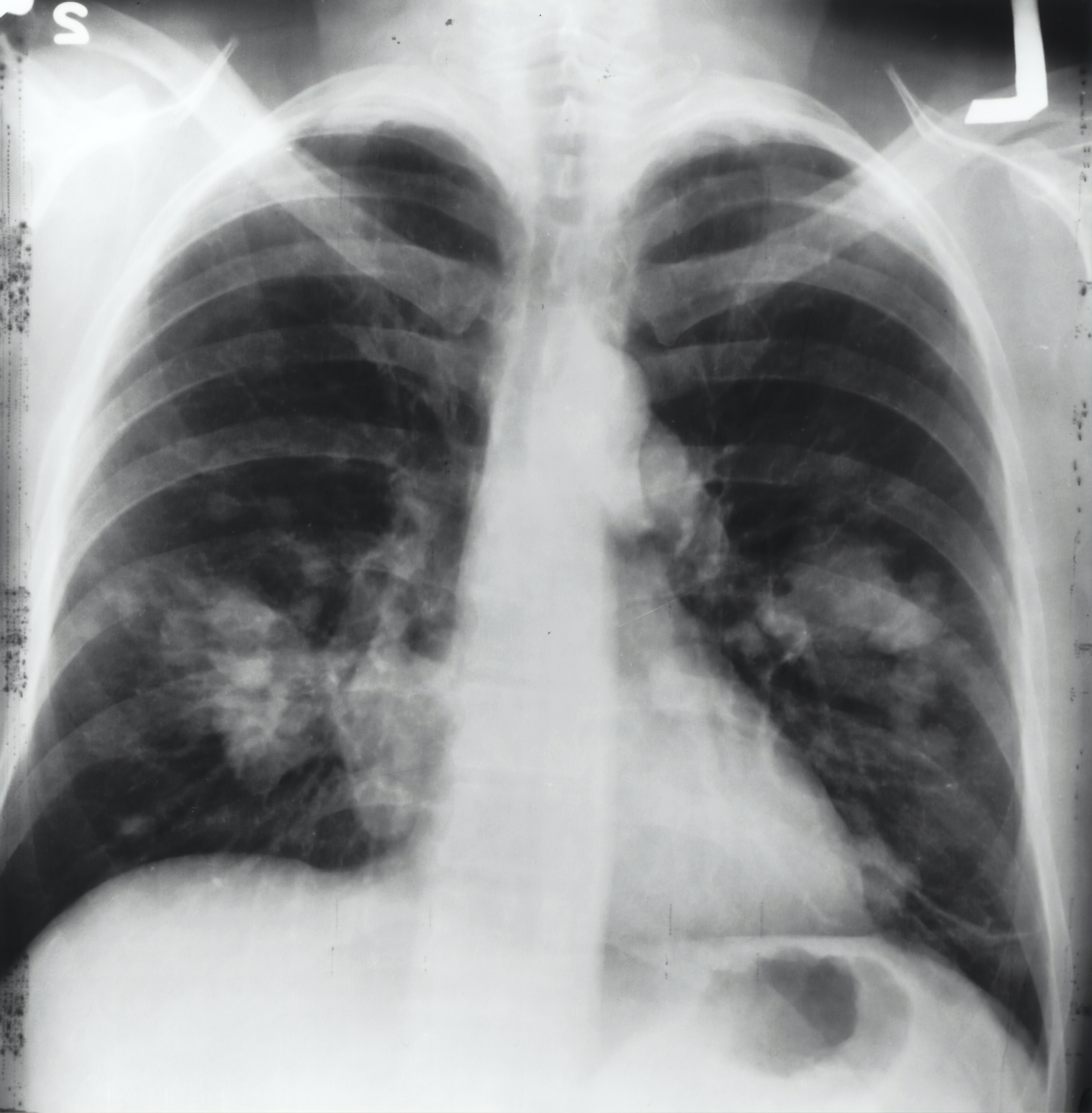Which factors contribute to the hapiness of a nation? 2022 is coming, let us look back the global hapiness over time!
In this post, we are studying the World Hapiness Report dataset, which is a landmark survey of the state of global happiness. The dataset is useful for interdisciplinary fields, ranging from economics, public health to psycholgy and development policy. The dataset contains 2 parts, the world hapiness report over time and the report for the year 2021.
import numpy as np
import pandas as pd
import matplotlib.pyplot as plt
import seaborn as sns
import sklearn.linear_model
import matplotlib.gridspec as gs
import seaborn as sns
df = pd.read_csv("world-happiness-report.csv")
df.head()
| Country name | year | Life Ladder | Log GDP per capita | Social support | Healthy life expectancy at birth | Freedom to make life choices | Generosity | Perceptions of corruption | Positive affect | Negative affect | |
|---|---|---|---|---|---|---|---|---|---|---|---|
| 0 | Afghanistan | 2008 | 3.724 | 7.370 | 0.451 | 50.80 | 0.718 | 0.168 | 0.882 | 0.518 | 0.258 |
| 1 | Afghanistan | 2009 | 4.402 | 7.540 | 0.552 | 51.20 | 0.679 | 0.190 | 0.850 | 0.584 | 0.237 |
| 2 | Afghanistan | 2010 | 4.758 | 7.647 | 0.539 | 51.60 | 0.600 | 0.121 | 0.707 | 0.618 | 0.275 |
| 3 | Afghanistan | 2011 | 3.832 | 7.620 | 0.521 | 51.92 | 0.496 | 0.162 | 0.731 | 0.611 | 0.267 |
| 4 | Afghanistan | 2012 | 3.783 | 7.705 | 0.521 | 52.24 | 0.531 | 0.236 | 0.776 | 0.710 | 0.268 |
df2021 = pd.read_csv("world-happiness-report-2021.csv")
df2021.head()
| Country name | Regional indicator | Ladder score | Standard error of ladder score | upperwhisker | lowerwhisker | Logged GDP per capita | Social support | Healthy life expectancy | Freedom to make life choices | Generosity | Perceptions of corruption | Ladder score in Dystopia | Explained by: Log GDP per capita | Explained by: Social support | Explained by: Healthy life expectancy | Explained by: Freedom to make life choices | Explained by: Generosity | Explained by: Perceptions of corruption | Dystopia + residual | |
|---|---|---|---|---|---|---|---|---|---|---|---|---|---|---|---|---|---|---|---|---|
| 0 | Finland | Western Europe | 7.842 | 0.032 | 7.904 | 7.780 | 10.775 | 0.954 | 72.0 | 0.949 | -0.098 | 0.186 | 2.43 | 1.446 | 1.106 | 0.741 | 0.691 | 0.124 | 0.481 | 3.253 |
| 1 | Denmark | Western Europe | 7.620 | 0.035 | 7.687 | 7.552 | 10.933 | 0.954 | 72.7 | 0.946 | 0.030 | 0.179 | 2.43 | 1.502 | 1.108 | 0.763 | 0.686 | 0.208 | 0.485 | 2.868 |
| 2 | Switzerland | Western Europe | 7.571 | 0.036 | 7.643 | 7.500 | 11.117 | 0.942 | 74.4 | 0.919 | 0.025 | 0.292 | 2.43 | 1.566 | 1.079 | 0.816 | 0.653 | 0.204 | 0.413 | 2.839 |
| 3 | Iceland | Western Europe | 7.554 | 0.059 | 7.670 | 7.438 | 10.878 | 0.983 | 73.0 | 0.955 | 0.160 | 0.673 | 2.43 | 1.482 | 1.172 | 0.772 | 0.698 | 0.293 | 0.170 | 2.967 |
| 4 | Netherlands | Western Europe | 7.464 | 0.027 | 7.518 | 7.410 | 10.932 | 0.942 | 72.4 | 0.913 | 0.175 | 0.338 | 2.43 | 1.501 | 1.079 | 0.753 | 0.647 | 0.302 | 0.384 | 2.798 |
df.rename(columns={'Country name': 'Country'}, inplace=True)
df2021.rename(columns={'Country name': 'Country'}, inplace=True)
Explanatory data analysis for the year 2021
c1 = "mediumturquoise"
c2 = "lightpink"
c3 = "sandybrown"
high_c = c1
low_c = c2
Countries with the highest and lowest happiness index in 2021
#top 10 and lowesttom 10 countries in 2021 report
fig= plt.figure(figsize=(15,15))
g=gs.GridSpec(ncols=1, nrows=2, figure=fig)
plt.suptitle("Countries with the highest and lowest happiness index in 2021", family='Serif', weight='bold', size=20)
ax1=plt.subplot(g[0,0])
top_10=df2021.head(10)
lowest_10= df2021.tail(10)
ax1=sns.barplot(data=top_10, x=top_10['Ladder score'],
y=top_10['Country']+ " (" + top_10['Regional indicator'] + ")", color = c1)
#ax1.set_xlabel('')
ax1.xaxis.set_visible(False)
ax1.annotate(" 10 countries with highest happiness index",xy=(8,2), family='Serif', weight='bold', size=12)
ax2=plt.subplot(g[1,0], sharex=ax1)
ax2=sns.barplot(data=lowest_10, x=lowest_10['Ladder score'],
y=lowest_10['Country']+ " (" + lowest_10['Regional indicator'] + ")", color = c2)
ax2.annotate(" 10 countries with lowest happiness index",xy=(8,2), family='Serif', weight='bold', size=12)
for s in ['left','right','top','bottom']:
ax1.spines[s].set_visible(False)
ax2.spines[s].set_visible(False)
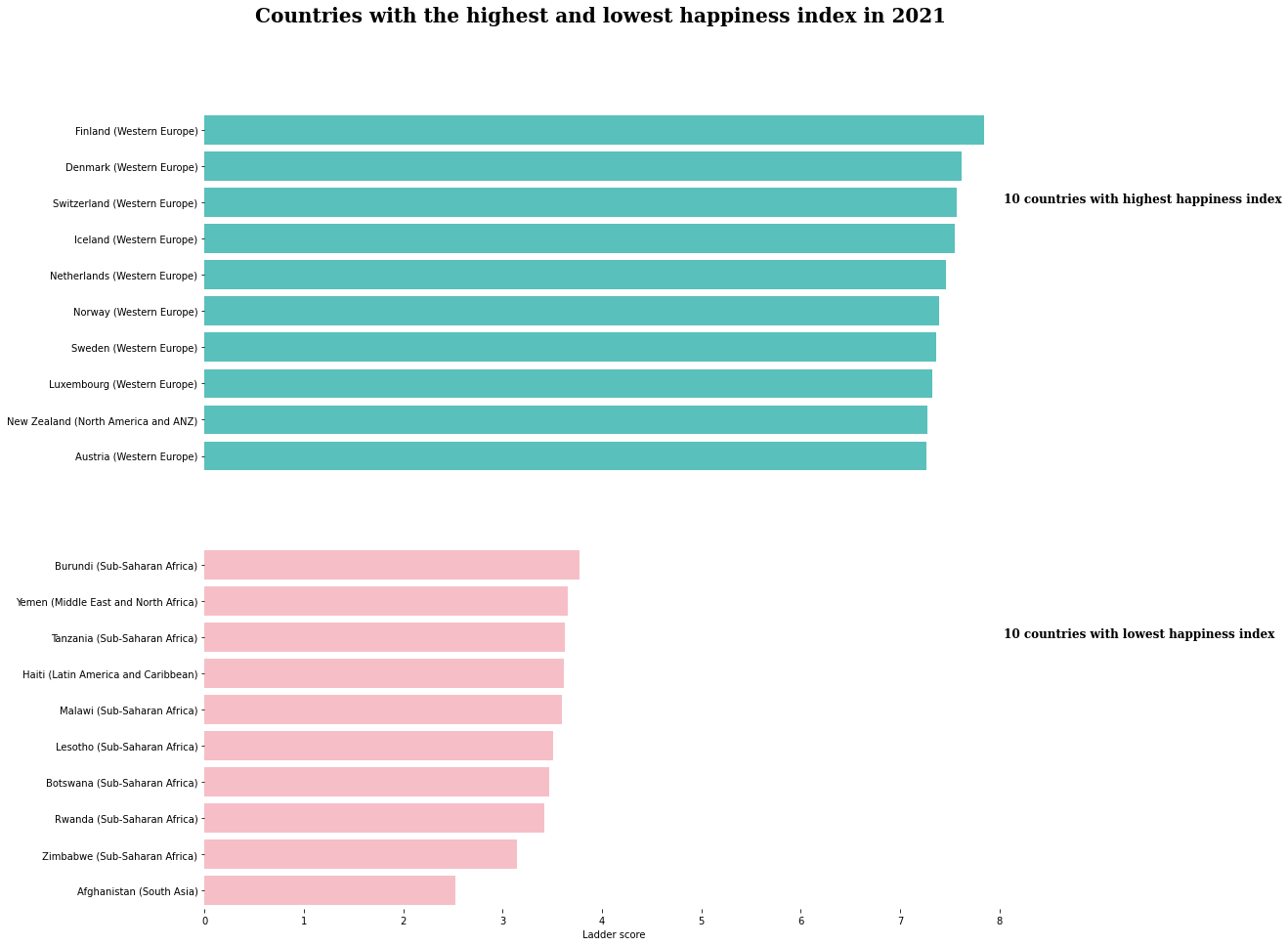
Ladder score distribution by Regional indicator
fig=plt.figure(figsize=(15,8))
plt.title("Ladder score distribution by Regional indicator")
sns.kdeplot(df2021['Ladder score'], fill=True,hue=df2021['Regional indicator'], shade=True, linewidth=2, multiple='layer')
plt.axvline(df2021['Ladder score'].mean(), c='black',ls='--')
plt.text(x=df2021['Ladder score'].mean(),y=-0.01,s='Population mean', size=15)
for s in ['left','right','top','bottom']:
plt.gca().spines[s].set_visible(False)
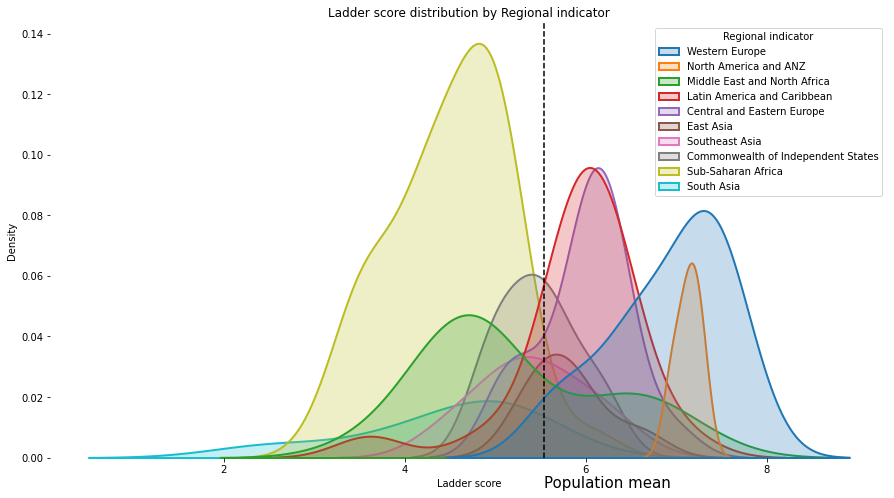
Correlaztion analysis for the year 2021
corr = df2021.corr()
mask = np.zeros_like(corr)
mask[np.triu_indices_from(mask)] = True
plt.figure(figsize=(15,15))
sns.heatmap(corr, mask=mask, center=0, annot=True,
square=True, linewidths=.5, cbar_kws={"shrink": .5})
plt.show()
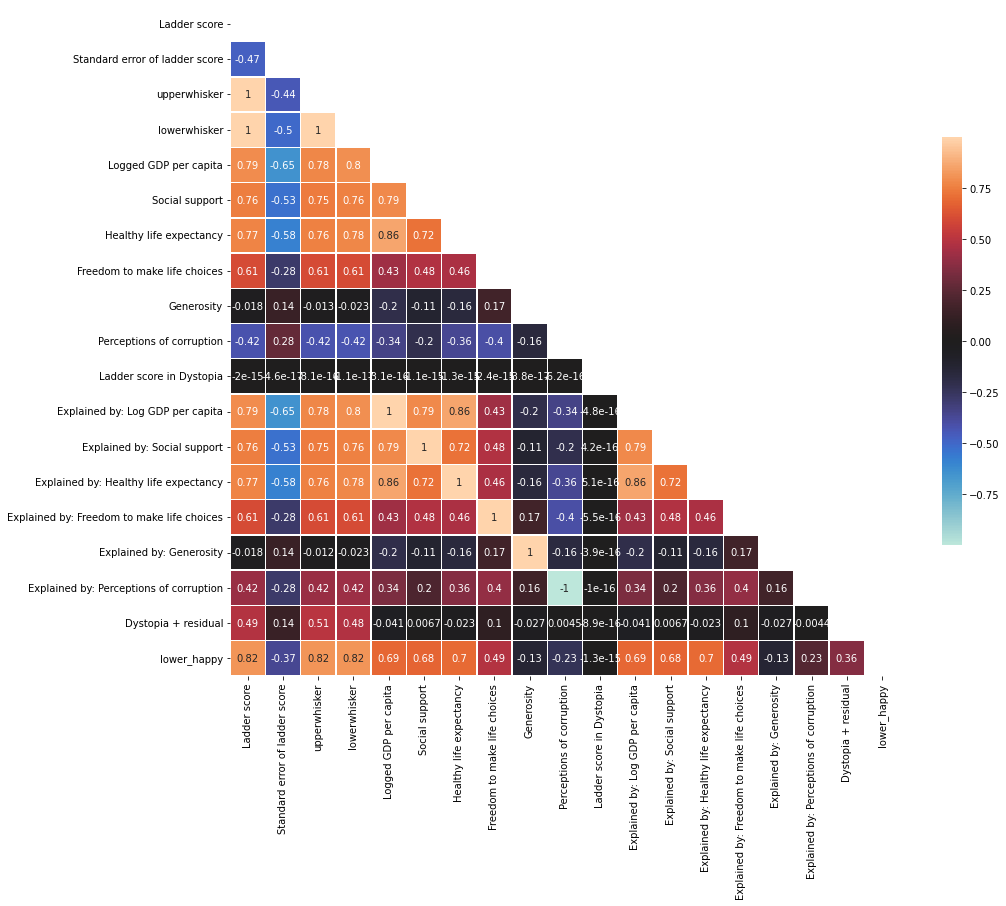
#refined
continuous = ['Logged GDP per capita',
'Social support',
'Healthy life expectancy',
'Freedom to make life choices',
'Generosity',
'Perceptions of corruption']
sns.pairplot(df2021, vars = continuous, hue = 'Ladder score')
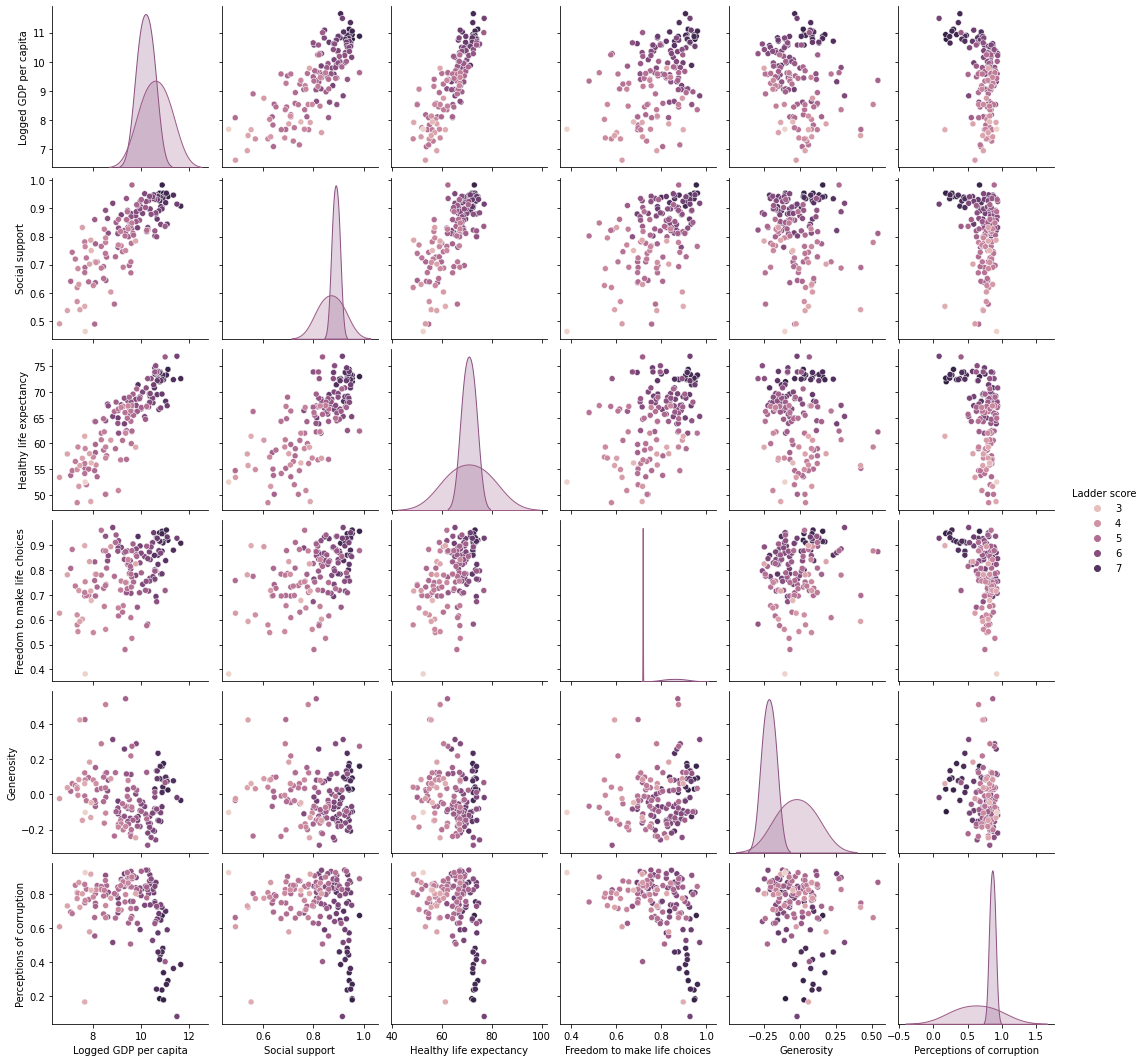
df2021[continuous].hist(bins=50, figsize=(20,15))
plt.show()
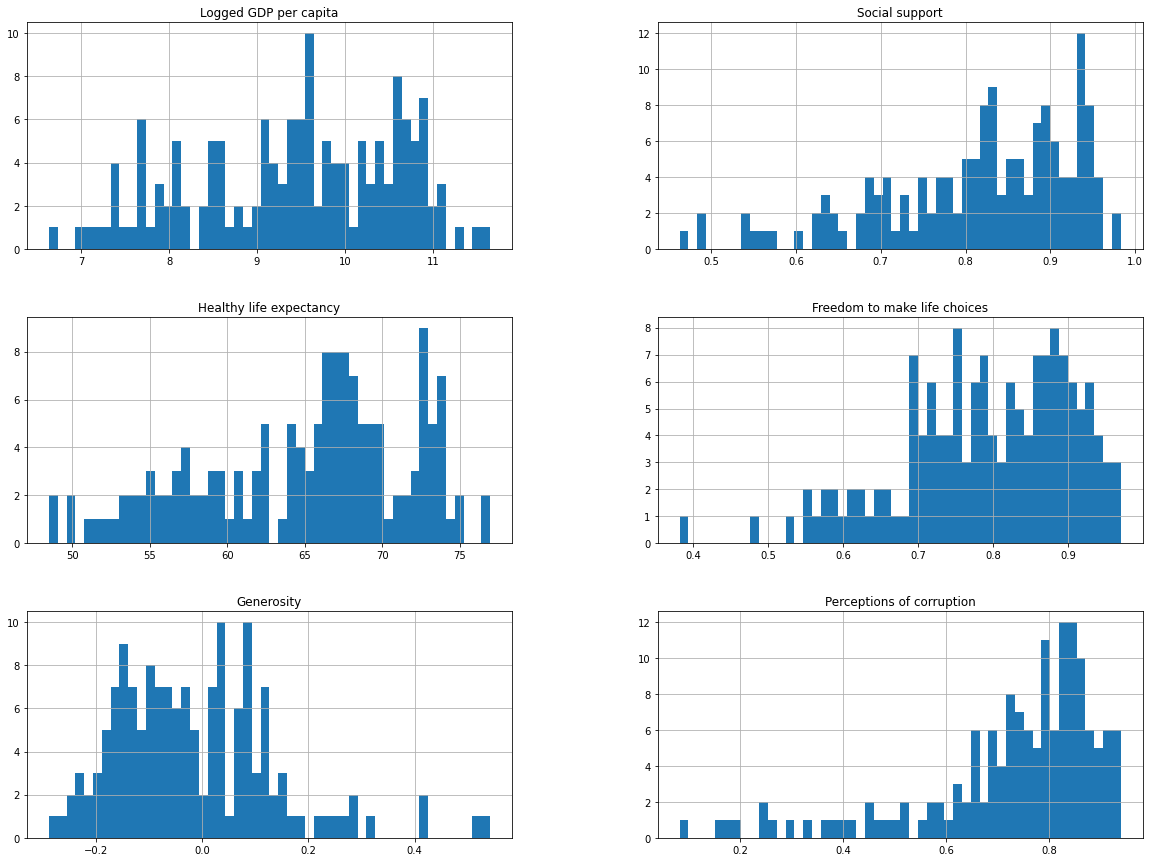
Correlation GDP-Hapiness index
# get GDP for the x-axis and Life Satisfaction for the y-axis
X = df2021['Logged GDP per capita'].values.reshape(-1, 1)
y = df2021['Ladder score'].values.reshape(-1, 1)
X.shape, y.shape
((149, 1), (149, 1))
# Select a Linear Model
model = sklearn.linear_model.LinearRegression()
# Train the Model
model.fit(X, y)
LinearRegression()
# let's visualize our model, because it's a linear one, we can plot it using two points
X = [[7], [11]]
y_hat = model.predict(X)
df2021.plot(kind='scatter', x='Logged GDP per capita', y='Ladder score')
plt.plot(X, y_hat, c='red')
plt.show()
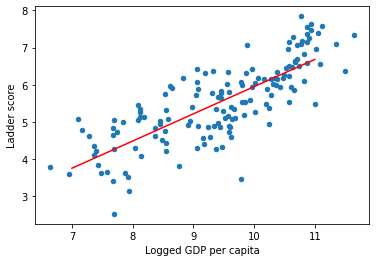
Distribution of ladder score compared to other factors
happiness_mean = df2021['Ladder score'].mean()
df2021['lower_happy'] = df2021['Ladder score'].apply(lambda x: 0 if x < happiness_mean else 1)
background_color = '#fbfbfb'
fig = plt.figure(figsize=(12, 6), dpi=150,facecolor=background_color)
gs = fig.add_gridspec(2, 3)
gs.update(wspace=0.2, hspace=0.5)
plot = 0
for row in range(0, 2):
for col in range(0, 3):
locals()["ax"+str(plot)] = fig.add_subplot(gs[row, col])
locals()["ax"+str(plot)].set_facecolor(background_color)
locals()["ax"+str(plot)].tick_params(axis='y', left=False)
locals()["ax"+str(plot)].get_yaxis().set_visible(False)
locals()["ax"+str(plot)].set_axisbelow(True)
for s in ["top","right","left"]:
locals()["ax"+str(plot)].spines[s].set_visible(False)
plot += 1
plot = 0
Yes = df2021[df2021['lower_happy'] == 1]
No = df2021[df2021['lower_happy'] == 0]
for variable in continuous:
sns.kdeplot(Yes[variable], ax=locals()["ax"+str(plot)], color=high_c,ec='black', shade=True, linewidth=1.5, alpha=0.9, zorder=3, legend=False)
sns.kdeplot(No[variable],ax=locals()["ax"+str(plot)], color=low_c, shade=True, ec='black',linewidth=1.5, alpha=0.9, zorder=3, legend=False)
locals()["ax"+str(plot)].grid(which='major', axis='x', zorder=0, color='gray', linestyle=':', dashes=(1,5))
locals()["ax"+str(plot)].set_xlabel(variable, fontfamily='monospace')
plot += 1
Xstart, Xend = ax0.get_xlim()
Ystart, Yend = ax0.get_ylim()
ax0.text(Xstart, Yend+(Yend*0.5), 'Differences between happy & unhappy countries', fontsize=17, fontweight='bold', fontfamily='sansserif',color='#323232')
ax0.text(Xstart, Yend+(Yend*0.25), 'There are large differences, with GDP & Social Support being clear\nperhaps more interesting though, unhappy countries appear to be more generous', fontsize=12, fontweight='light', fontfamily='monospace',color='gray')
plt.show()
findfont: Font family ['sansserif'] not found. Falling back to DejaVu Sans.
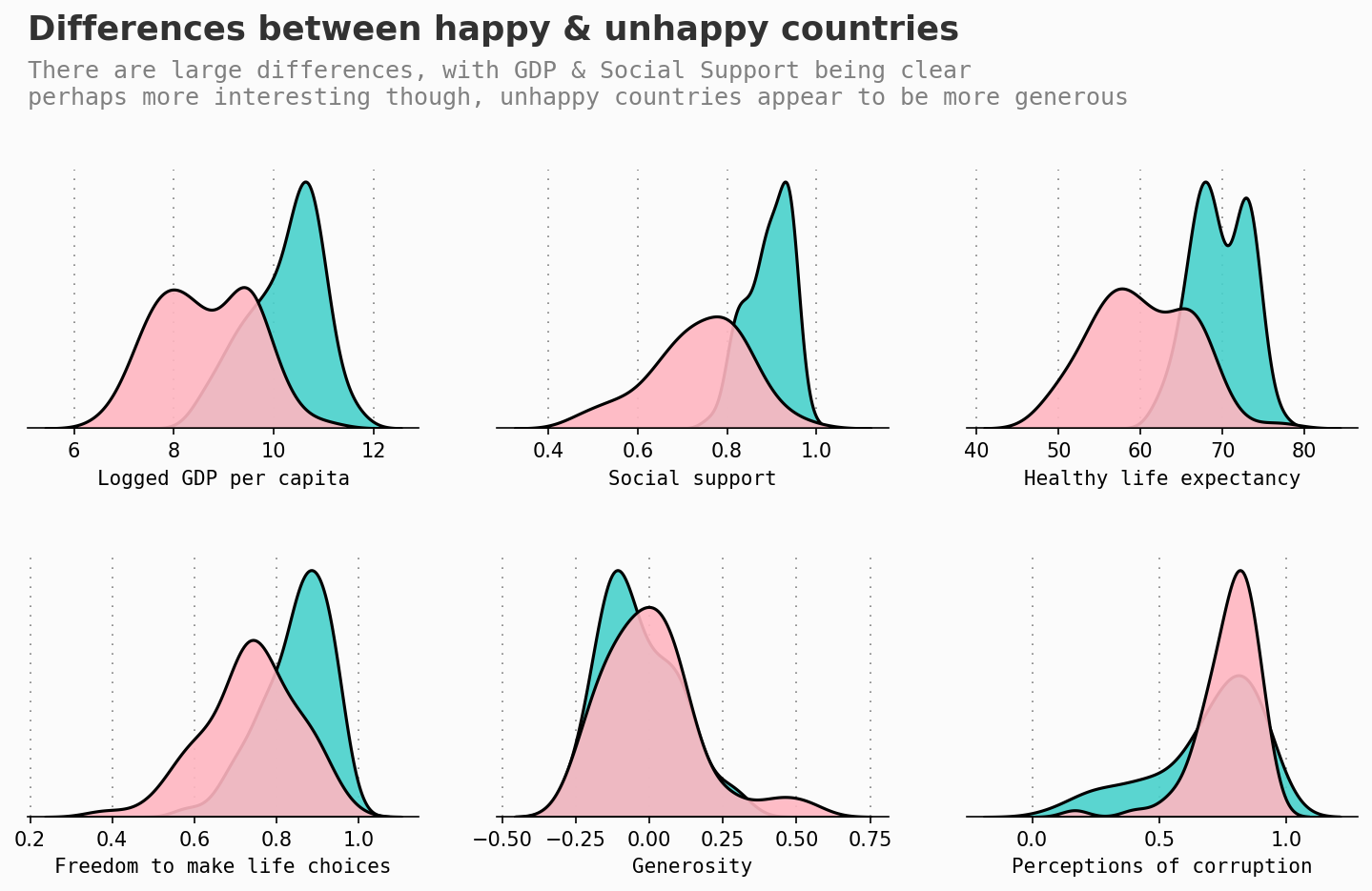
A continental view
continent_score = df2021.groupby('Regional indicator')['Healthy life expectancy','Logged GDP per capita','Perceptions of corruption','Freedom to make life choices','Ladder score'].mean().reset_index()
background = "#fbfbfb"
fig, ax = plt.subplots(1,1, figsize=(10, 5),dpi=150)
fig.patch.set_facecolor(background) # figure background color
cmap = [c2,c1]
color_map = ['#e7e9e7' for _ in range(10)]
color_map[9] = c1 # color highlight
color_map[5] = c1
color_map[8] = c2
color_map[6] = c2
ax.set_facecolor(background)
sns.scatterplot(data=continent_score, x=continent_score['Healthy life expectancy'], y=continent_score['Ladder score'],hue=continent_score['Regional indicator'], alpha=0.9,ec='black',palette=color_map,size=df2021["Ladder score"], legend=False, sizes=(5, 600))
ax.set_xlabel("Life Expectancy",fontfamily='monospace',color='gray')
ax.set_ylabel("Happiness Index Score",fontfamily='monospace',color='gray')
ax.tick_params(axis = 'both', which = 'major', labelsize = 10)
for s in ["top","right","left"]:
ax.spines[s].set_visible(False)
ax.text(55,7.5,'Happiness Score & Life Expectancy by Continent',fontfamily='sansserif',fontweight='normal',fontsize=17,weight='bold',color='#323232')
ax.text(55,7.3,'There are clear distinctions, with four stand-out continents',fontfamily='monospace',fontweight='light',fontsize=12,color='gray')
L = ax.legend(frameon=False,loc="upper center", bbox_to_anchor=(1.25, 0.8), ncol= 1)
plt.setp(L.texts, family='monospace')
L.get_frame().set_facecolor('none')
ax.tick_params(axis='both', which='both',left=False, bottom=False,labelbottom=True)
for i, txt in enumerate(continent_score['Regional indicator']):
ax.annotate(txt, (continent_score['Healthy life expectancy'][i]+0.5, continent_score['Ladder score'][i]),fontfamily='monospace')
plt.show()
/usr/local/lib/python3.7/dist-packages/ipykernel_launcher.py:1: FutureWarning: Indexing with multiple keys (implicitly converted to a tuple of keys) will be deprecated, use a list instead.
"""Entry point for launching an IPython kernel.
No handles with labels found to put in legend.
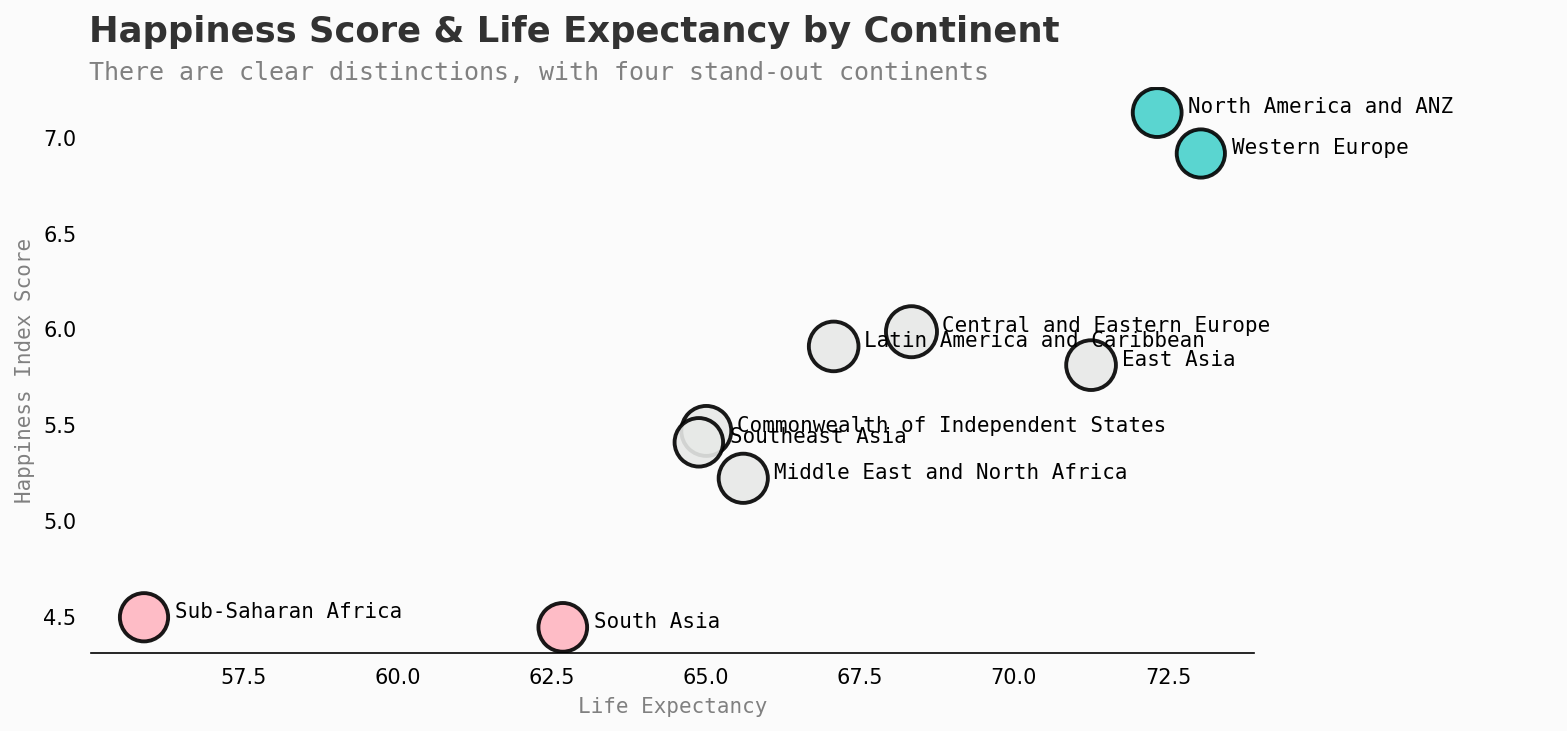
Happiness index over time
background = "#fbfbfb"
fig, ax = plt.subplots(1,1, figsize=(10, 5),dpi=150)
fig.patch.set_facecolor(background) # figure background color
ax.set_facecolor(background)
# Reduced list as too many to show all at once
top_list_ = df.groupby('Country')['Life Ladder'].mean().sort_values(ascending=False).reset_index()[:20].sort_values(by='Life Ladder',ascending=True)
plot = 1
for country in top_list_['Country']:
mean = df[df['Country'] == country].groupby('Country')['Life Ladder'].mean()
# historic scores
sns.scatterplot(data=df[df['Country'] == country], y=plot, x='Life Ladder',color='lightgray',s=50,ax=ax)
# mean score
sns.scatterplot(data=df[df['Country'] == country], y=plot, x=mean,color='gold',ec='black',linewidth=1,s=75,ax=ax)
#2021 score
sns.scatterplot(data=df2021[df2021['Country'] == country], y=plot, x='Ladder score',color=c1,ec='black',linewidth=1,s=75,ax=ax)
plot += 1
ax.set_yticks(top_list_.index+1)
ax.set_yticklabels(top_list_['Country'][::-1], fontdict={'horizontalalignment': 'right'}, alpha=0.7)
ax.tick_params(axis=u'both', which=u'both',length=0)
ax.set_xlabel("Happiness Index Score",fontfamily='monospace',color='gray')
for s in ['top','right','bottom','left']:
ax.spines[s].set_visible(False)
Xstart, Xend = ax.get_xlim()
Ystart, Yend = ax.get_ylim()
ax.hlines(y=top_list_.index+1, xmin=Xstart, xmax=Xend, color='gray', alpha=0.5, linewidth=.3, linestyles='--')
ax.set_axisbelow(True)
ax.text(6.25, Yend+4.3, 'Happiness Index Scores through the years', fontsize=17, fontweight='bold', fontfamily='sansserif',color='#323232')
ax.text(6.25, Yend+0.75,
'''
Countries scores do vary over time, however they remain farily consistent
It is interesting that Finland's 2021 score is amongst the highest of all time
''', fontsize=12, fontweight='light', fontfamily='monospace',color='gray')
plt.annotate('2021\nscore', xy=(7.842, 19), xytext=(8.2, 11),
arrowprops=dict(facecolor='steelblue',arrowstyle="->",connectionstyle="arc3,rad=.3"), fontsize=10,fontfamily='monospace',ha='center', color=c1)
plt.annotate('Mean\nscore', xy=(7.6804, 20), xytext=(8.2, 16),
arrowprops=dict(facecolor='steelblue',arrowstyle="->",connectionstyle="arc3,rad=.5"), fontsize=10,fontfamily='monospace',ha='center', color='gold')
plt.show()
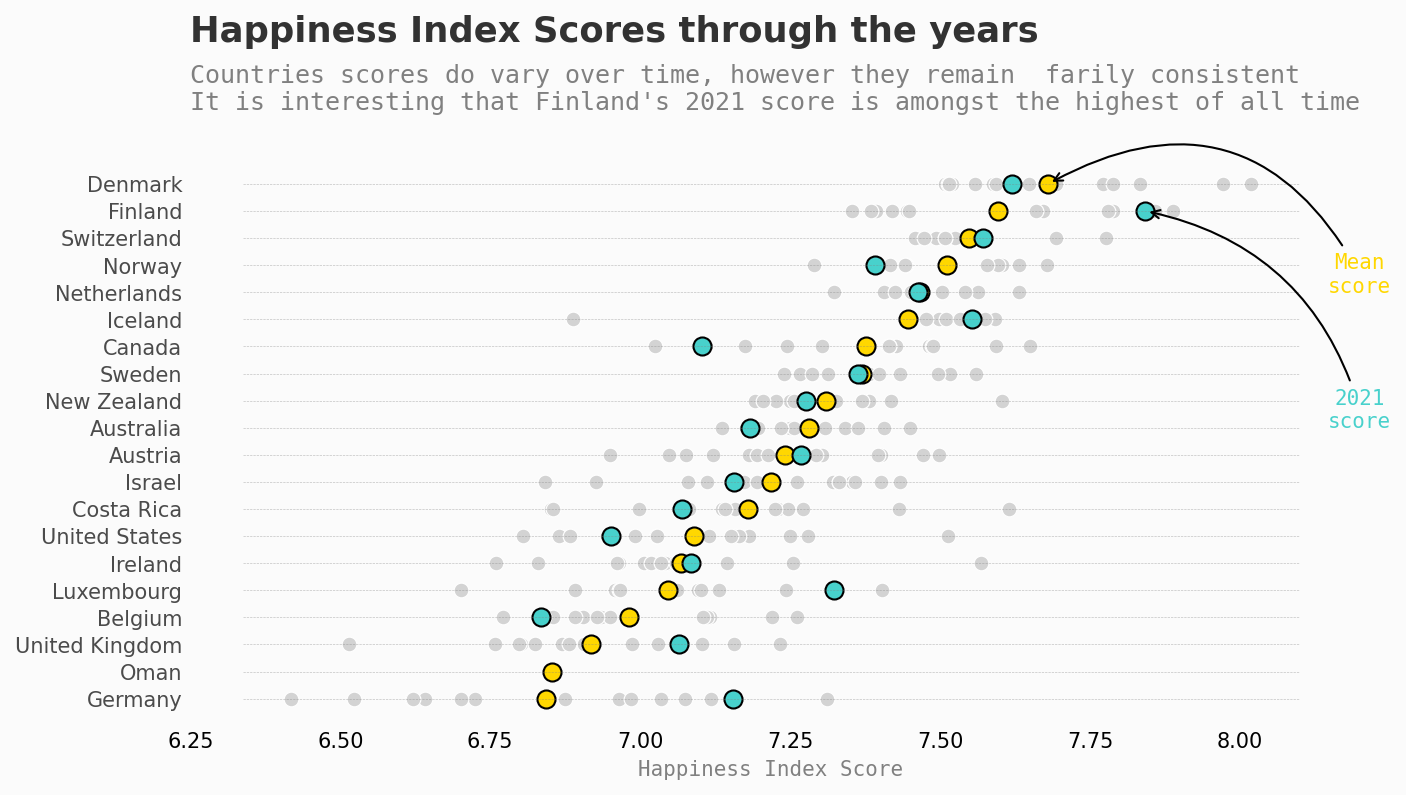
A global view over time
import plotly.express as px
fig = px.choropleth(data_frame=df, locations='Country',
locationmode="country names",
color='Life Ladder',
animation_frame='year',
range_color = "",
#color_continuous_scale = [c2,c1])
color_continuous_scale = px.colors.sequential.RdBu)
fig.show()
fig.write_html("world_hapiness.html")
Regression
df.drop("year", axis=1).hist(bins=50, figsize=(20,15))
plt.show()
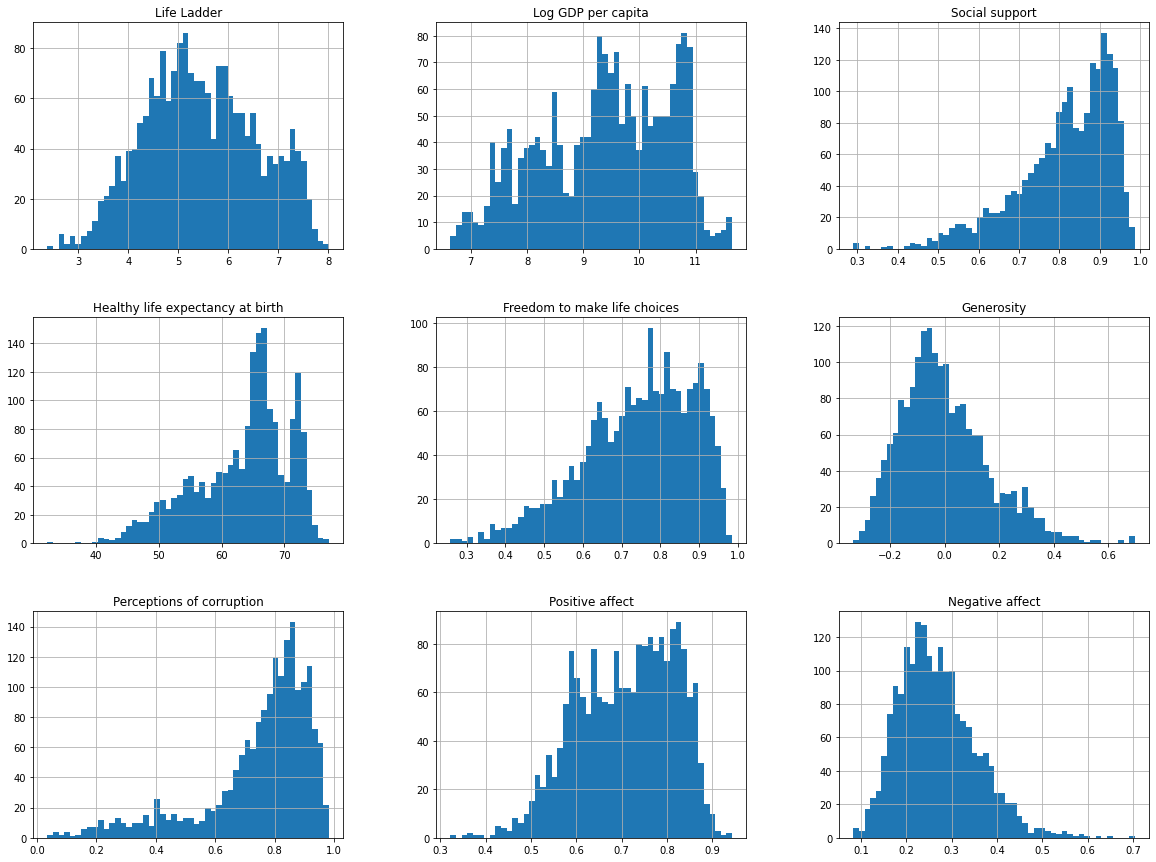
Create a test set
df_ = df2021[['Ladder score',
'Standard error of ladder score', 'upperwhisker', 'lowerwhisker',
'Logged GDP per capita', 'Social support', 'Healthy life expectancy',
'Freedom to make life choices', 'Generosity',
'Perceptions of corruption']]
Transformation pipelines
from sklearn.pipeline import Pipeline
from sklearn.preprocessing import StandardScaler
num_pipeline = Pipeline([
('std_scaler', StandardScaler())
])
df_ = num_pipeline.fit_transform(df_)
df_.shape
(149, 10)
from sklearn.model_selection import train_test_split
train_set, test_set = train_test_split(df_, test_size=0.2, random_state=42)
train_set.shape, test_set.shape
((119, 10), (30, 10))
Select and Train Model
Linear Model
from sklearn.linear_model import LinearRegression
from sklearn.metrics import mean_squared_error
lin_reg = LinearRegression()
lin_reg.fit(X=train_set[:, 1:], y=train_set[:,0])
LinearRegression()
from sklearn.metrics import mean_squared_error
predictions = lin_reg.predict(test_set[:, 1:])
lin_mse = mean_squared_error(test_set[:, 0], predictions)
lin_rmse = np.sqrt(lin_mse)
lin_rmse
0.00031220104713910665
Decision Tree
from sklearn.tree import DecisionTreeRegressor
tree_reg = DecisionTreeRegressor(max_depth = 4)
tree_reg.fit(X=train_set[:, 1:], y=train_set[:,0])
DecisionTreeRegressor(max_depth=4)
predictions = tree_reg.predict(test_set[:, 1:])
lin_mse = mean_squared_error(test_set[:, 0], predictions)
lin_rmse = np.sqrt(lin_mse)
lin_rmse
0.1019944246040892
fig = plt.figure(figsize=(25,15))
sklearn.tree.plot_tree(tree_reg)
plt.show()
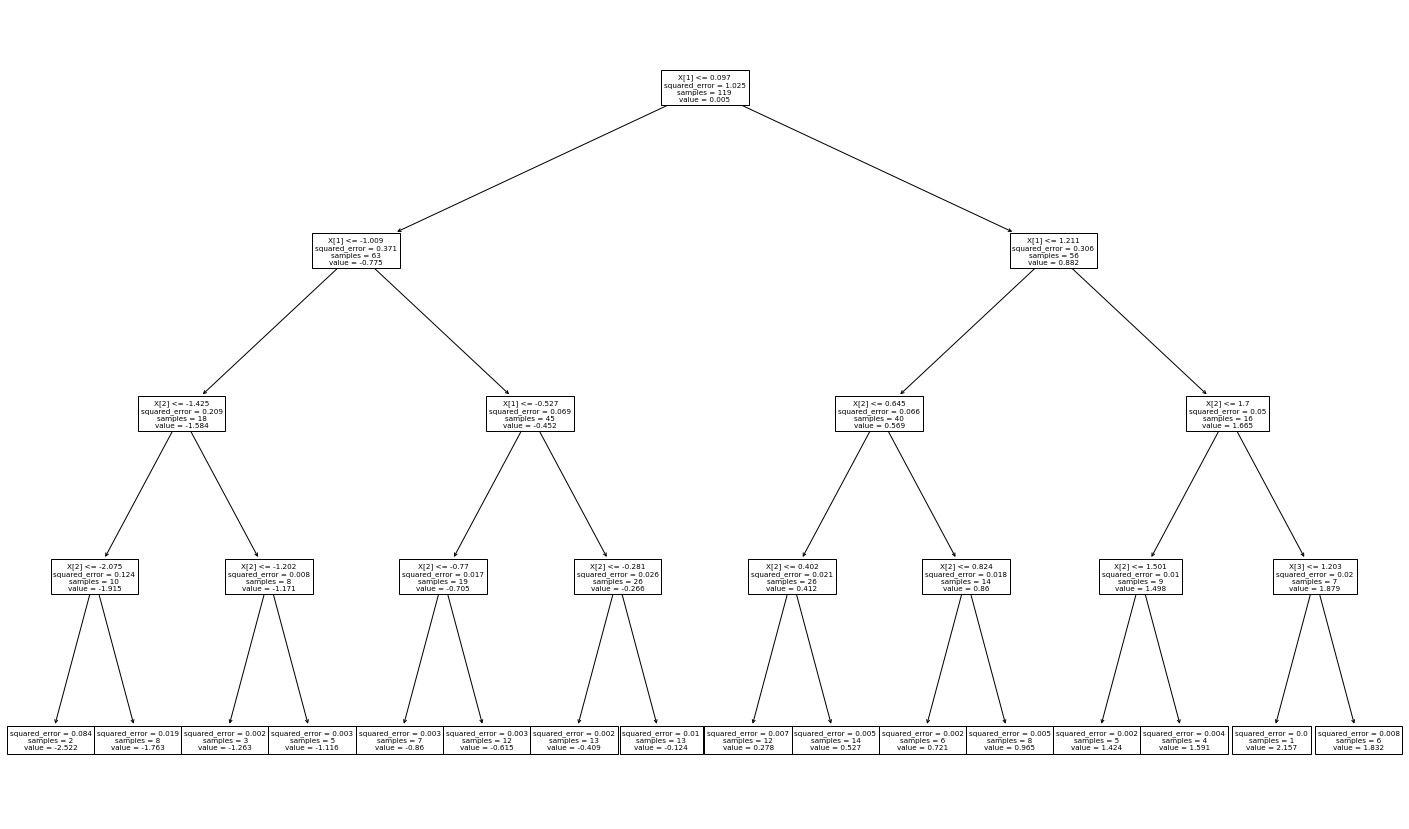
Cross-Validation
from sklearn.model_selection import cross_val_score
scores = cross_val_score(estimator=tree_reg, X=train_set[:, 1:], y=train_set[:,0]
, scoring='neg_mean_squared_error', cv=10)
tree_rmse_scores = np.sqrt(-scores)
print("Scores:", tree_rmse_scores)
print("Mean:", tree_rmse_scores.mean())
print("Standard Deviation:", tree_rmse_scores.std())
Scores: [0.08063915 0.12074651 0.10401294 0.11853572 0.16611299 0.07206908
0.11776827 0.13357675 0.1597485 0.25173151]
Mean: 0.13249414280237842
Standard Deviation: 0.04877781586110474
Ensemble Learning with the Random Forest
from sklearn.ensemble import RandomForestRegressor
forest_reg = RandomForestRegressor()
forest_reg.fit(X=train_set[:, 1:], y=train_set[:,0])
RandomForestRegressor()
forest_mse = mean_squared_error(y_true=test_set[:, 0], y_pred=forest_reg.predict(X=test_set[:, 1:]))
forest_rmse = np.sqrt(forest_mse)
forest_rmse
0.04082603271734864
scores = cross_val_score(estimator=forest_reg, X=train_set[:, 1:], y=train_set[:,0]
, scoring='neg_mean_squared_error', cv=10)
forest_rmse_scores = np.sqrt(-scores)
print("Scores:", forest_rmse_scores)
print("Mean:", forest_rmse_scores.mean())
print("Standard Deviation:", forest_rmse_scores.std()) # much better now
Scores: [0.02182252 0.0849461 0.02198475 0.07533847 0.15627785 0.05930377
0.03977674 0.05536409 0.06649303 0.25151086]
Mean: 0.08328181891050981
Standard Deviation: 0.06690200008334836
Finetune with Grid-Search
from sklearn.model_selection import GridSearchCV
param_grid = [
{'n_estimators': [3, 10, 30], 'max_features': [2, 4, 6, 8]},
{'bootstrap': [False], 'n_estimators': [3, 10], 'max_features': [2, 3, 4]}
]
forest_reg = RandomForestRegressor()
grid_search = GridSearchCV(estimator=forest_reg, param_grid=param_grid, scoring='neg_mean_squared_error', cv=5, return_train_score=True, n_jobs=-1)
grid_search.fit(X=train_set[:, 1:], y=train_set[:,0])
GridSearchCV(cv=5, estimator=RandomForestRegressor(), n_jobs=-1,
param_grid=[{'max_features': [2, 4, 6, 8],
'n_estimators': [3, 10, 30]},
{'bootstrap': [False], 'max_features': [2, 3, 4],
'n_estimators': [3, 10]}],
return_train_score=True, scoring='neg_mean_squared_error')
grid_search.best_params_
{'max_features': 8, 'n_estimators': 30}
grid_search.best_estimator_
RandomForestRegressor(max_features=8, n_estimators=30)
cvres = grid_search.cv_results_
for mean_score, params in zip(cvres['mean_test_score'], cvres['params']):
print(np.sqrt(-mean_score), params)
0.34082522900363926 {'max_features': 2, 'n_estimators': 3}
0.24008412892225006 {'max_features': 2, 'n_estimators': 10}
0.21986291868367538 {'max_features': 2, 'n_estimators': 30}
0.17776709950308564 {'max_features': 4, 'n_estimators': 3}
0.1468019626867688 {'max_features': 4, 'n_estimators': 10}
0.12742906434054158 {'max_features': 4, 'n_estimators': 30}
0.14940029641388528 {'max_features': 6, 'n_estimators': 3}
0.11440546627455518 {'max_features': 6, 'n_estimators': 10}
0.12027962076790268 {'max_features': 6, 'n_estimators': 30}
0.10803897201257359 {'max_features': 8, 'n_estimators': 3}
0.12045244766329144 {'max_features': 8, 'n_estimators': 10}
0.0991261383049853 {'max_features': 8, 'n_estimators': 30}
0.19098266384099238 {'bootstrap': False, 'max_features': 2, 'n_estimators': 3}
0.21873900029484047 {'bootstrap': False, 'max_features': 2, 'n_estimators': 10}
0.17707483768792917 {'bootstrap': False, 'max_features': 3, 'n_estimators': 3}
0.15222447554234794 {'bootstrap': False, 'max_features': 3, 'n_estimators': 10}
0.15742856042032355 {'bootstrap': False, 'max_features': 4, 'n_estimators': 3}
0.11996174232954583 {'bootstrap': False, 'max_features': 4, 'n_estimators': 10}
Randomized Search
from sklearn.model_selection import RandomizedSearchCV
from scipy.stats import randint
param_distribs = {
'n_estimators': randint(low=1, high=200),
'max_features': randint(low=1, high=9),
}
forest_reg = RandomForestRegressor(random_state=42)
rnd_search = RandomizedSearchCV(forest_reg, param_distributions=param_distribs,
n_iter=10, cv=5, scoring='neg_mean_squared_error', random_state=42)
rnd_search.fit(X=train_set[:, 1:], y=train_set[:,0])
RandomizedSearchCV(cv=5, estimator=RandomForestRegressor(random_state=42),
param_distributions={'max_features': <scipy.stats._distn_infrastructure.rv_frozen object at 0x7fd1efe54250>,
'n_estimators': <scipy.stats._distn_infrastructure.rv_frozen object at 0x7fd1efea9590>},
random_state=42, scoring='neg_mean_squared_error')
cvres = rnd_search.cv_results_
for mean_score, params in zip(cvres["mean_test_score"], cvres["params"]):
print(np.sqrt(-mean_score), params)
0.1026364152276238 {'max_features': 7, 'n_estimators': 180}
0.11023158498480463 {'max_features': 5, 'n_estimators': 15}
0.14301237257745014 {'max_features': 3, 'n_estimators': 72}
0.10729242519657402 {'max_features': 5, 'n_estimators': 21}
0.10407094852494171 {'max_features': 7, 'n_estimators': 122}
0.14463386329172387 {'max_features': 3, 'n_estimators': 75}
0.14467805582633234 {'max_features': 3, 'n_estimators': 88}
0.10730669220705276 {'max_features': 5, 'n_estimators': 100}
0.1014822451619872 {'max_features': 8, 'n_estimators': 152}
0.14540216293970593 {'max_features': 3, 'n_estimators': 150}
feature_importances = grid_search.best_estimator_.feature_importances_
feature_importances
array([5.62869082e-04, 4.81859114e-01, 5.08040907e-01, 4.28212124e-04,
6.71086804e-04, 4.51735910e-04, 9.18665718e-04, 1.49157615e-03,
5.57583298e-03])


